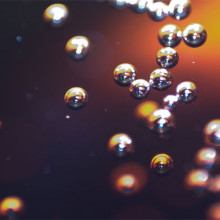We find out why ice cubes can make fizzy drinks bubble over, by asking a French champagne specialist!
In this episode

00:00 - Why does ice make fizzy drinks bubble over?
Why does ice make fizzy drinks bubble over?
Gerard - My name is Gerard Liger-Belair. I'm a Physics Professor in Reims University in France. So the physics of the bubbles, it's my area of expertise.
Hannah - So, yes, perfectly placed. Display the answer of Bella's question on why fizzy drinks fizz over when an ice cube is added.
Gerard - So, the main reason is that when you have a soda or fizzy water, it means that the liquid holds carbon dioxide molecules in excess. So, all those carbon dioxide molecule in excess must escape from the liquid medium. But to escape into the form of bubbles, the liquid needs some tiny imperfections in the glass and, at the micrometre scale, the surface of the ice cube is not at all smooth. It is full of tiny cracks. All these imperfections, when they will be in touch with the liquid supersaturated with carbon dioxide molecules in excess, those tiny molecules will be able to produce what we call from the scientific point of view, the nucleation process. It means that the liquid will be able to nucleate bubbles. This is the reason why when you introduce ice cubes in your soda or in your fizzy water, it will promote a bubbling process.
Hannah - Thank you Gerard, Champagne Bubble Physicist based in Reims, France.
So, soda drinks have been carbonated so they're full of carbon dioxide molecules, floating around in a liquid and that needs to escape. These carbon dioxide molecules can only form stable bubbles when they land on a surface with minute indentations, like the side of a glass or the surface of the liquid. An ice cube has lots of bubble promoting imperfect surfaces, so lots of bubbles form, causing the glass to fizz over. You can experiment further with this concept at home, suck on an ice cube to make the surface smoother and then add to the liquid, and less bubble "fizz-over" should occur...
- Previous Australia's First BBQ
- Next Hyperloop Trains










Comments
Add a comment